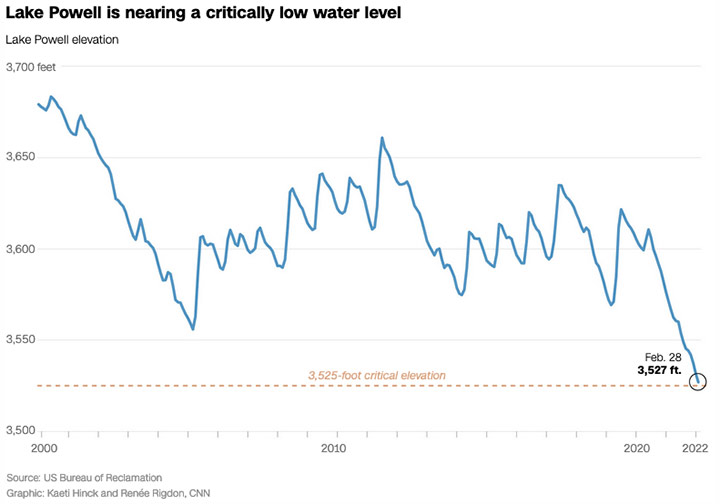On Monday, March 7, reporter Jerd Smith posted the following bit of news about the Colorado River, on the Water Education Colorado website:
The St. George News reports that Lake Powell is expected to drop below the critical 3,525-foot elevation mark, below which hydropower production would be cutoff. The lake is expected to rebound in May as the spring snowmelt begins…
A concerned citizen reading this brief news report might conclude that, at the expected 3,525-foot elevation, hydropower production will be cut off. Such a situation would be challenging, of course, for electric companies throughout the American Southwest who purchase bargain-rate electricity from the Western Area Power Administration. (I believe La Plata Electric Association — LPEA — purchases some of its electricity through WAPA, but don’t quote me.)
The words chosen by reporter Jerd Smith might misleading, because — according to other information sources — hydropower in fact continues to be produced at 3,525 feet elevation.
Here’s the actual report from the St. George News:
SALT LAKE CITY — The Bureau of Reclamation announced Friday that Lake Powell will decline below 3,525 feet in elevation, close to the depth that power generation would be cut off, reflecting the abnormally dry winter season…
The Bureau of Reclamation has picked the elevation “3,525 feet” as a concerning benchmark, because it’s close to the actual elevation at which the Glenn Canyon Dam will stop generating electricity — which is “3,490 feet”. The Bureau of Reclamation picked “3,525” as the elevation at which we should all start worrying, if we weren’t already.
When illustrating this same situation in a recent news article, CNN published a graph where the elevation where hydropower stops — 3,490 feet — doesn’t even appear. We have to imagine it.
The Bureau of Reclamation can make a prediction like this with some level of confidence, because they are required to continue draining Lake Powell, even when it gets dangerously low.
Lake Powell doesn’t just “decline” all by itself, although these news stories might give someone that impression. Lake Powell is being actively drained of its water. WAPA cannot generate any electricity without running water through its turbines, and the Bureau of Reclamation (BOR) is required (under certain agreements) to release water from Lake Powell… to try and keep Lake Mead, about 200 miles downstream, full enough to continue producing its own hydroelectricity. BOR expects to release a total of about 7.5 million acre-feet from Lake Powell during 2022. To facilitate that massive release of water, the BOR will, if necessary, drain reservoirs upstream, along the Colorado River and its tributaries.
We can consider the following excerpt from a 1,200-word CNN article by reporter Rachel Ramirez, posted on March 3.
Drought contingency plans define the 3,525-foot mark as a significant “target elevation” for the reservoir, under which the situation becomes dire. As of Thursday, Lake Powell had fallen to just over 3,526 feet in elevation, which is just over 24% of capacity and less than two feet away from the critical level.
“We’re kind of in some uncharted territory, socially and economically,” Justin Mankin, assistant professor of geography at Dartmouth College and co-lead of the National Oceanic and Atmospheric Administration’s Drought Task Force, told CNN. “It’s totally within reason to expect that the next couple of weeks or so for [Lake Powell] to fall below the critical level.”
Nowhere, in her 1,200-word article, does Ms. Ramirez mention the fact that BOR has been draining 7.5 million acre-feet from Lake Powell, year after year. She (like many other news reporters) uses language like “Lake Powell had fallen to just over 3,526 feet in elevation”… which can easily be interpreted as indicating that Lake Powell “had fallen” all by itself, due to some awful accident like… well, like climate change.
In my opinionated opinion, truthful reporting about Lake Powell would read more like this:
As of Thursday, Lake Powell had been mercilessly drained to just over 3,526 feet in elevation…
But thoroughly honest reporting about western water issues is often absent from the news.
At least the St. George News admitted, near the conclusion of its March 5 article, that BOR is actively draining Lake Powell.
Consistent with the provisions of the Drought Response Operations Agreement, [BOR]… twice has implemented proactive drought response operations that together have helped protect Lake Powell’s target elevation: 1) sending an additional 161,000 acre-feet of water from Blue Mesa and Flaming Gorge reservoirs to Lake Powell July 2021-October 2021, and 2) temporarily reducing monthly releases from Glen Canyon Dam in order to hold back 350,000 acre-feet of water in Lake Powell from January 2022-April 2022 for release later in the year.
Yes, BOR will thoughtfully reduce monthly releases this winter, holding back 350,000 acre-feet, to be released from Lake Powell later in the year.

We’ve been discussing local water issues here in the Daily Post for the past 17 years, trying to understand water issues in the American Southwest. Here in Archuleta County, for example, our local water district, Pagosa Area Water and Sanitation, has implemented voluntary water restrictions just twice, during the 29 years I’ve lived here.
Data provided by PAWSD suggests that customers purchase about 1,250 acre-feet of treated drinking water each year.
In Archuleta County, according to a study by the U.S. Geological Survey, agricultural users — owners of large acreage, where acres of grass get irrigated, and cows live a pleasant life — consumed about 47,050 acre-feet of water in 2015… nearly 40 times as much water as municipal users. Theoretically, if Archuleta County ranchers were able to cut their water use by 3%… we would save twice the amount of water sold to municipal customers each year.
Theoretically.
It’s interesting to note, meanwhile, that the majority of farm and ranch operations in the county have less than $10,000 in annual sales. (USDA, 2018)
Some things to think about, when we’re not distracted by misleading media stories.

